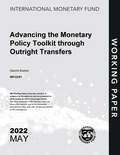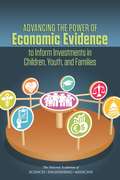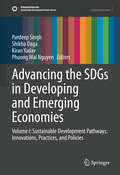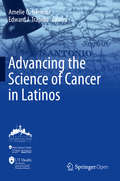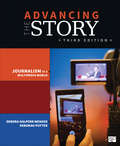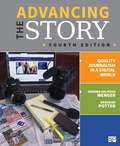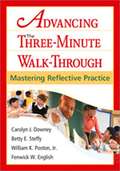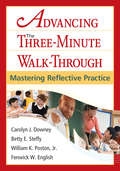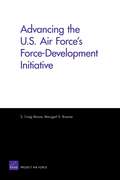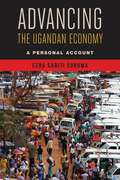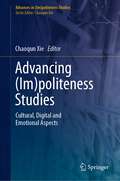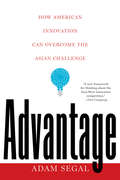- Table View
- List View
Advancing the Monetary Policy Toolkit through Outright Transfers (Imf Working Papers)
by BuetzerA report from the International Monetary Fund.
Advancing the Myth: Sustaining an Iconic Brand Over Time
by Douglas B. HoltEven the most successful iconic brands routinely stumble when it comes to managing a brand myth so that it remains vital for many years. To extend a powerful myth, the brand's communications must steer a path between two traps: milking the myth to capitalize on its popularity, and abandoning the myth entirely to pursue the next big trend.
Advancing the Power of Economic Evidence to Inform Investments in Children, Youth, and Families
by Engineering Medicine National Academies of SciencesIn recent years, the U.S. federal government has invested approximately $463 billion annually in interventions that affect the overall health and well-being of children and youth, while state and local budgets have devoted almost double that amount. The potential returns on these investments may not only be substantial but also have long-lasting effects for individuals and succeeding generations of their families. Ideally, those tasked with making these investments would have available to them the evidence needed to determine the cost of all required resources to fully implement and sustain each intervention, the expected returns of the investment, to what extent these returns can be measured in monetary or nonmonetary terms, and who will receive the returns and when. As a result of a number of challenges, however, such evidence may not be effectively produced or applied. Low-quality evidence and/or a failure to consider the context in which the evidence will be used may weaken society’s ability to invest wisely, and also reduce future demand for this and other types of evidence. Advancing the Power of Economic Evidence to Inform Investments in Children, Youth, and Families highlights the potential for economic evidence to inform investment decisions for interventions that support the overall health and well-being of children, youth, and families. This report describes challenges to the optimal use of economic evidence, and offers recommendations to stakeholders to promote a lasting improvement in its quality, utility, and use.
Advancing the Profession of Exercise Physiology
by Tommy BooneIn recent times, the ASEP (American Society of Exercise Physiologists) leaders have developed and implemented academic standards to promote professionalism in academic programs throughout the U.S. The effort represents a significant change in the scope and the monitoring of the exercise physiologists' accountability. Through these new standards, all academic exercise physiologists are challenged by ASEP to accept responsibility for promoting the professionalization and self-regulation that will lead to lead to improved client and patient care when prescribing exercise medicine. Accreditation helps to reduce unnecessary variation within and between academic programs. Moreover, given the collaborative improvement in academic programs and faculty responsibility to the undergraduate students, the quality of their educational care will be significantly improved. Academic exercise physiologists must take responsibility for where exercise physiology is today and take responsibility to the evolving state of exercise physiology and student market-driven career opportunities in exercise medicine. Advancing the Profession of Exercise Physiology provides understanding and guidance on the importance and the significance of academic leadership in promoting the profession of exercise physiology as a healthcare profession that is founded on professionalism, accreditation, ethical practice, and entrepreneurial skills. This new volume examines the ethical need for professionalism in exercise physiology, which is, in turn, imperative for future growth and sustainability.
Advancing the Regional Commons in the New East Asia (Politics in Asia)
by Siriporn Wajjwalku Kong Chong Ho Osamu YoshidaAdvancing the Regional Commons in the New East Asia highlights a number of interests which members of ASEAN and Plus Three countries collectively recognize. This set of common interests includes not only economic development but also social development. Written by nationals in their respective countries, the different chapters in this volume highlights the different foundations for such common interests and these reflect the different constructive ways in which ASEAN and Plus Three countries come to see a multi-strand cooperative partnership. The task of advancing the regional commons will involve efforts to recognise and nurture ASEAN’s and Plus Three’s common interests in terms of broad social development, managing regional security issues, the development of a regional infrastructure, and ensuring collective progress for all member countries. ASEAN becomes a community in 2015 and the idea of embracing, protecting, sustaining and advancing the regional commons become a vital process. Concurrently, APT has also realized that its contribution to the achieving goal of community and promoting regional commons is absolutely critical for both ASEAN and the Plus Three countries. Academics will find in this volume a clear analytical treatment of issues which regional groupings are currently facing and this can provide the basis for a comparative analysis. This volume will also be of interest to students and the general public looking for a systematic introduction to the successful implementation of cooperative ventures and also an assessment of the new collaborative energies which shape this dynamic region.
Advancing the Rule of Law Abroad
by Rachel KleinfeldIn the modern era, political leaders and scholars have declared the rule of law to be essential to democracy, a necessity for economic growth, and a crucial tool in the fight for security at home and stability abroad. The United States has spent billions attempting to catalyze rule-of-law improvements within other countries. Yet despite the importance of the goal to core foreign policy needs, and the hard work of hundreds of practitioners on the ground, the track record of successful rule-of-law promotion has been paltry.In Advancing the Rule of Law Abroad, Rachel Kleinfeld describes the history and current state of reform efforts and the growing movement of second-generation reformers who view the rule of law not as a collection of institutions and laws that can be built by outsiders, but as a relationship between the state and society that must be shaped by those inside the country for lasting change. Based on research in countries from Indonesia to Albania, Kleinfeld makes a compelling case for new methods of reform that can have greater chances of success.This book offers a comprehensive overview of this growing area of policy action where diplomacy and aid meet the domestic policies of other states. Its insights into the practical methods and moral complexities of supporting reform within other countries will be useful to practitioners and students alike.
Advancing the SDGs in Developing and Emerging Economies: Volume I: Sustainable Development Pathways: Innovations, Practices, and Policies (Sustainable Development Goals Series)
by Pardeep Singh Shikha Daga Kiran Yadav Phuong Mai NguyenThis contributed volume, the first in a set of two, explores the intersection of innovation and sustainability, investigating how transformative practices across various industries and regions are advancing the Sustainable Development Goals (SDGs). It highlights a wide network of solutions and real-world examples that integrate various SDG principles into business and government strategies. The chapters cover diverse topics, including green finance, human resource management, sustainable marketing, and the adoption of cutting-edge technologies, showcasing how innovation is driving the global transition towards a more sustainable future. The geographic diversity represented in this section—including contributions from Italy, Brazil, Vietnam, India, and Malaysia—provides a rich, multi-regional perspective on sustainable development. The chapters reflect the dynamic ways in which innovation is being harnessed to address pressing global challenges, with a focus on both local and global contexts. Each chapter offers in-depth case studies and practical examples, illustrating how SDG principles are being integrated into various sectors to foster long-term sustainability. Together, these contributions emphasize the critical role of innovative strategies and practices in achieving the SDGs and building a more resilient, sustainable world for future generations.
Advancing the Science of Cancer in Latinos
by Amelie G. Ramirez Edward J. TrapidoThis open access book gives an overview of the sessions, panel discussions, and outcomes of the Advancing the Science of Cancer in Latinos conference, held in February 2018 in San Antonio, Texas, USA, and hosted by the Mays Cancer Center and the Institute for Health Promotion Research at UT Health San Antonio. Latinos – the largest, youngest, and fastest-growing minority group in the United States – are expected to face a 142% rise in cancer cases in coming years. Although there has been substantial advancement in cancer prevention, screening, diagnosis, and treatment over the past few decades, addressing Latino cancer health disparities has not nearly kept pace with progress. The diverse and dynamic group of speakers and panelists brought together at the Advancing the Science of Cancer in Latinos conference provided in-depth insights as well as progress and actionable goals for Latino-focused basic science research, clinical best practices, community interventions, and what can be done by way of prevention, screening, diagnosis, and treatment of cancer in Latinos. These insights have been translated into the chapters included in this compendium; the chapters summarize the presentations and include current knowledge in the specific topic areas, identified gaps, and top priority areas for future cancer research in Latinos. Topics included among the chapters: Colorectal cancer disparities in Latinos: Genes vs. EnvironmentBreast cancer risk and mortality in women of Latin American originDifferential cancer risk in Latinos: The role of dietOvercoming barriers for Latinos on cancer clinical trialsEs tiempo: Engaging Latinas in cervical cancer researchEmerging policies in U.S. health care Advancing the Science of Cancer in Latinos proves to be an indispensable resource offering key insights into actionable targets for basic science research, suggestions for clinical best practices and community interventions, and novel strategies and advocacy opportunities to reduce health disparities in Latino communities. It will find an engaged audience among researchers, academics, physicians and other healthcare professionals, patient advocates, students, and others with an interest in the broad field of Latino cancer.
Advancing the Science of Cancer in Latinos: Building Collaboration for Action
by Amelie G. Ramirez Edward J. TrapidoThis open access book is a collection of articles based on presentations from the 2020 Advancing the Science of Cancer in Latinos conference that gives an overview of conference outcomes. The vision of the conference has been to unite researchers, scientists, physicians and other healthcare professionals, patient advocates, and students from across the world to discuss research advancements, identify gaps, and develop actionable goals to translate basic research findings into clinical best practices, effective community interventions, and professional training programs to decrease cancer risks and eliminate cancer disparities for Latinos. This conference comes at an especially important time when Latinos – the largest and youngest minority group in the U.S. – are expected to face a 142% rise in cancer cases in the coming years. Disparities continue to impact this population in critical areas: access to preventive and clinical care, changeable risk behaviors, quality of life, and mortality. Each chapter summarizes the presentation and includes current knowledge in the specific topic areas, identified gaps, and opportunities for future research. Topics explored include: Applying an Exposome-Wide (ExWAS) Approach to Latino Cancer DisparitiesSupportive Care Needs and Coping Strategies Used by Latino Men Cancer SurvivorsOptimizing Engagement of the Latino Community in Cancer ResearchLatino Population Growth and the Changing Demography of CancerImplementation Science to Enhance the Value of Cancer Research in Latinos A Strength-Based Approach to Cancer Prevention in LatinxsOvercoming Clinical Research Disparities by Advancing Inclusive Research Advancing the Science of Cancer in Latinos: Building Collaboration for Action will appeal to a wide readership due to its comprehensive coverage of topics ranging from basic science and community prevention research to clinical practice to policy. The book is an essential resource for physicians and other medical professionals, researchers, scientists, academicians, patient advocates, and students. It also will appeal to policy-makers, NCI-designated cancer centers, academic centers, state health departments, and community organizations.
Advancing the Science of Climate Change
by National Research Council of the National AcademiesClimate change is occurring, is caused largely by human activities, and poses significant risks for-and in many cases is already affecting-a broad range of human and natural systems. The compelling case for these conclusions is provided in Advancing the Science of Climate Change , part of a congressionally requested suite of studies known as America's Climate Choices. While noting that there is always more to learn and that the scientific process is never closed, the book shows that hypotheses about climate change are supported by multiple lines of evidence and have stood firm in the face of serious debate and careful evaluation of alternative explanations. As decision makers respond to these risks, the nation's scientific enterprise can contribute through research that improves understanding of the causes and consequences of climate change and also is useful to decision makers at the local, regional, national, and international levels. The book identifies decisions being made in 12 sectors, ranging from agriculture to transportation, to identify decisions being made in response to climate change. Advancing the Science of Climate Change calls for a single federal entity or program to coordinate a national, multidisciplinary research effort aimed at improving both understanding and responses to climate change. Seven cross-cutting research themes are identified to support this scientific enterprise. In addition, leaders of federal climate research should redouble efforts to deploy a comprehensive climate observing system, improve climate models and other analytical tools, invest in human capital, and improve linkages between research and decisions by forming partnerships with action-oriented programs.
Advancing the Science to Improve Population Health: Proceedings of a Workshop
by Engineering Medicine Health Theresa Wizemann Roundtable on Population Health Improvement National Academies of Sciences Medicine Division Board on Population Health Public Health PracticeIn September 2015, the National Academies of Sciences, Engineering, and Medicine hosted a workshop to explore the basic and translational research needs for population health science, and to discuss specific research priorities and actions to foster population health improvement. The workshop was designed to provide frameworks for understanding population health research and its role in shaping and having an effect on population health, identify individual and institutional facilitators and challenges regarding the production, communication, and use of research for population health improvement, and identify key areas for future research critical to the advancement of population health improvement. This publication summarizes the presentations and discussions from the workshop.
Advancing the Story: Journalism in a Multimedia World
by Debora R. Wenger Deborah PotterThis fully updated Third Edition of Advancing the Story, by Debora Halpern Wenger and Deborah Potter, builds on the essential strengths of the original text by providing clear instruction on reporting and producing for multiple platforms, real-world examples, advice from professional journalists and exercises to stimulate additional conversations. By focusing on the skills journalists need to leverage social media and capitalize on the use of mobile devices, the authors explore the role data-driven journalism is playing in the profession. Throughout the book, new screen shots, images, research and examples of broadcast and multimedia reporting bring concepts to life. Additionally, a greater emphasis on journalism ethics permeates the book, with each chapter now including a series of discussion starters to ensure that students consider the ethical implications of their journalistic decisions.
Advancing the Story: Journalism in a Multimedia World (Third Edition)
by Debora R. Wenger Deborah PotterThis fully updated Third Edition of Advancing the Story, by Debora Halpern Wenger and Deborah Potter, builds on the essential strengths of the original text by providing clear instruction on reporting and producing for multiple platforms, real-world examples, advice from professional journalists and exercises to stimulate additional conversations. By focusing on the skills journalists need to leverage social media and capitalize on the use of mobile devices, the authors explore the role data-driven journalism is playing in the profession. Throughout the book, new screen shots, images, research and examples of broadcast and multimedia reporting bring concepts to life. Additionally, a greater emphasis on journalism ethics permeates the book, with each chapter now including a series of discussion starters to ensure that students consider the ethical implications of their journalistic decisions.
Advancing the Story: Quality Journalism in a Digital World
by Debora R. Wenger Deborah PotterUpdated Edition of Bestseller! It’s a multimedia world, and today’s journalists must develop a multimedia mindset. How does this way of thinking change the newsgathering and news production processes? Having conceived of and written their book in this changed media landscape, broadcast veterans Debora Halpern Wenger and Deborah Potter seamlessly build on the fundamentals of good news reporting while teaching students to use depth, interactivity and immediacy as they maximize the advantages of each platform. While retaining the book’s clear instruction and advice from those in the trenches, Advancing the Story, Fourth Edition has been updated to reflect the latest issues and trends with: greater emphasis on social media and mobile media to gather, promote and disseminate news content; expanded coverage of media ethics and media law; extended examples of effective reporting across multiple platforms; updated writing exercises and new resources for reviewing AP style; and additional interviews with journalists at the forefront of industry changes.
Advancing the Story: Quality Journalism in a Digital World
by Debora R. Wenger Deborah PotterUpdated Edition of Bestseller! It’s a multimedia world, and today’s journalists must develop a multimedia mindset. How does this way of thinking change the newsgathering and news production processes? Having conceived of and written their book in this changed media landscape, broadcast veterans Debora Halpern Wenger and Deborah Potter seamlessly build on the fundamentals of good news reporting while teaching students to use depth, interactivity and immediacy as they maximize the advantages of each platform. While retaining the book’s clear instruction and advice from those in the trenches, Advancing the Story, Fourth Edition has been updated to reflect the latest issues and trends with: greater emphasis on social media and mobile media to gather, promote and disseminate news content; expanded coverage of media ethics and media law; extended examples of effective reporting across multiple platforms; updated writing exercises and new resources for reviewing AP style; and additional interviews with journalists at the forefront of industry changes.
Advancing the Three-Minute Walk-Through: Mastering Reflective Practice
by Carolyn J. Downey Betty E. Steffy William K. Poston Fenwick W. EnglishHow to successfully achieve a high-performance culture for entire schools! This sequel to the bestseller, The Three-Minute Classroom Walk-Through, helps school leaders put into practice a vision for changing schools one teacher at a time. While classic supervision often consists of superior-subordinate relationships, the authors offer a practical, time-saving alternative that cultivates autonomous teachers who are continually improving their skills. This ongoing and paperless walk-through model makes it possible to: Conduct frequent, short, informal professional conversations that reinforce a reflective teaching practice; Improve and strengthen relationships between principals, teachers, students, and parents; Collaborate regularly to evaluate, redefine, and strengthen best teaching practices.
Advancing the Three-Minute Walk-Through: Mastering Reflective Practice
by Carolyn J. Downey Dr William K. Poston Dr Fenwick W. English Betty E. Steffy-EnglishMaster the Downey Walk-Through for reflective dialogue with this must-have sequel! This sequel to the best-selling The Three-Minute Classroom Walk-Through gives school leaders an expanded examination of the Downey Walk-Through model of coaching and supervision. Clarifying common misconceptions and misapplications, the authors focus on how to engage teachers in reflection and professional dialogue after the walk-through to improve their practice. The resource provides examples, activities, and guidelines for changing schools one teacher at a time, and shows leaders how to: Provide effective follow-up discourse without criticizing or demoralizing teachers Build collegial relationships with staff Help teachers see their power to become continuously improving professionals
Advancing the U.S. Air Force's Force-Development Initiative
by S. Craig Moore Marygail K. BraunerThe following steps are recommended for consistent, efficient, and effective plans and means for improving the development of U.S. Air Force officers in their career fields: (1) identify the demand for jobs in the field grades-major, lieutenant colonel, and colonel; (2) ascertain the backgrounds that officers have accumulated (assess the supply); (3) compare supply with demand (gap analysis); and (4) plan ways to close the gaps.
Advancing the Ugandan Economy
by Ezra Sabiti SurumaInternal conflicts, dictatorship, and economic disintegration characterized the first twenty-five years of Uganda's independence from British colonial rule, which culminated in the reign of Idi Amin and a violent civil war. The country has since achieved an astounding turnaround of stability and growth. Advancing the Ugandan Economy is a first-hand look at the remarkable policy changes that took place from 1986 to 2012 and their effect in contrast with the turbulent events after independence.Ezra Suruma held several key positions in the Ugandan government during the nation's transition period, including minister of finance. His insightful recounting of those times demonstrates that African countries can achieve economic stability and sustain rapid growth when they meet at least two interdependent conditions: establishing a stable and secure political framework and unleashing entrepreneurialism. Suruma also highlights the strategic areas that still require fundamental reform if Uganda is to become a modern state and shares his vision for the future of his country.Rarely in African history has so much positive political and economic transformation of a country been achieved in such a short time. Suruma's account of the commitment, determination, vision, and dexterity of the Ugandan government holds invaluable lessons in managing the still complex policy challenges facing the African continent.
Advancing the Ugandan Economy: A Personal Account
by Ezra Sabiti SurumaInternal conflicts, dictatorship, and economic disintegration characterized the firsttwenty-five years of Uganda's independence from British colonial rule, which culminatedin the reign of Idi Amin and a violent civil war. The country has since achieved anastounding turnaround of stability and growth. Advancing the Ugandan Economy isa first-hand look at the remarkable policy changes that took place from 1986 to 2012and their effect in contrast with the turbulent events after independence. Ezra Suruma held several key positions in the Ugandan government during the nation'stransition period, including minister of finance. His insightful recounting of thosetimes demonstrates that African countries can achieve economic stability and sustainrapid growth when they meet at least two interdependent conditions: establishinga stable and secure political framework and unleashing entrepreneurialism. Surumaalso highlights the strategic areas that still require fundamental reform if Uganda is tobecome a modern state and shares his vision for the future of his country. Rarely in African history has so much positive political and economic transformationof a country been achieved in such a short time. Suruma's account of the commitment,determination, vision, and dexterity of the Ugandan government holds invaluablelessons in managing the still complex policy challenges facing the African continent.
Advancing: Cultural, Digital and Emotional Aspects (Advances in (Im)politeness Studies)
by Chaoqun XieThis volume pushes forward research on (im)politeness by focusing on interpersonal interaction's cultural, digital and emotional aspects. With contributions by established and emerging scholars in the field, this collection explores and expounds, with the combination of solid theoretical foundation and up-close empirical demonstration, how (im)politeness not only gives but also gives off communicative and interpersonal meaning in diverse cultural contexts. Included are chapters on how (im)politeness contributes to the construction of social reality online and in social media and how (im)politeness prompts and is prompted by emotional sensitivities. This book is of interest and value to students and researchers in the field and those keen to know how effective human existence and essence are possible through the lens of (im)politeness.
Advantage Miss Seeton (miss seeton mysteries #7)
by Hampton CharlesMiss Seeton’s summer outing to a tennis match serves up more than expected when Britain’s up-and-coming female tennis star is hounded by mysterious death threats. The girl’s father, stern Judge Thumper, seems to have provoked one of the miscreants passing before his bench-and the target of the ex-convict’s wrath isn't the crusty judge, but the athletic Miss Thumper. The police are counting on Miss Seeton to unravel some baffling clues before victory goes to the villain... game, set, and match.
Advantage: How American Innovation Can Overcome the Asian Challenge
by Adam Segal"Thoughtful . . . . [Segal's] striking argument is that the challengers [India and China] lack America's resilient, open and risk-taking culture." --Economist The emergence of India and China as economic powers has shifted the global landscape and called into question the ability of the United States to compete. Advantage sorts out the challenges the United States faces and focuses on what drives innovation, what constrains it, and what strengths we have to leverage. Entirely recasting the stakes of the debate, Adam Segal makes the compelling case for the crucial role of the "software" of innovation. By bolstering its politics, social relations, and institutions that move ideas from the lab to the marketplace, the United States can preserve its position as a global power. With up-to-the minute economic and political data, this is a resounding call to tie innovation to larger social goals in an age of global science and technology.
Advent A Calendar of Devotions 2018 (Pkg of #10)
by Sue MinkThe season of Advent provides an opportunity for spiritual renewal for followers of Christ. But often what happens is that we get so caught up in the hurry and rush, the hustle and bustle, the frantic pace of the season that we emerge more spiritually exhausted than refreshed and more disillusioned than inspired to face the coming of a new year. We may have tried so hard to enjoy the holiday season, to recapture a sense of wonder and mystery, only to end up asking, "Is that all there is?" The purpose of Advent A Calendar of Devotions 2018 is to help you focus on the things that truly matter during this busy season so that you can experience spiritual renewal.
